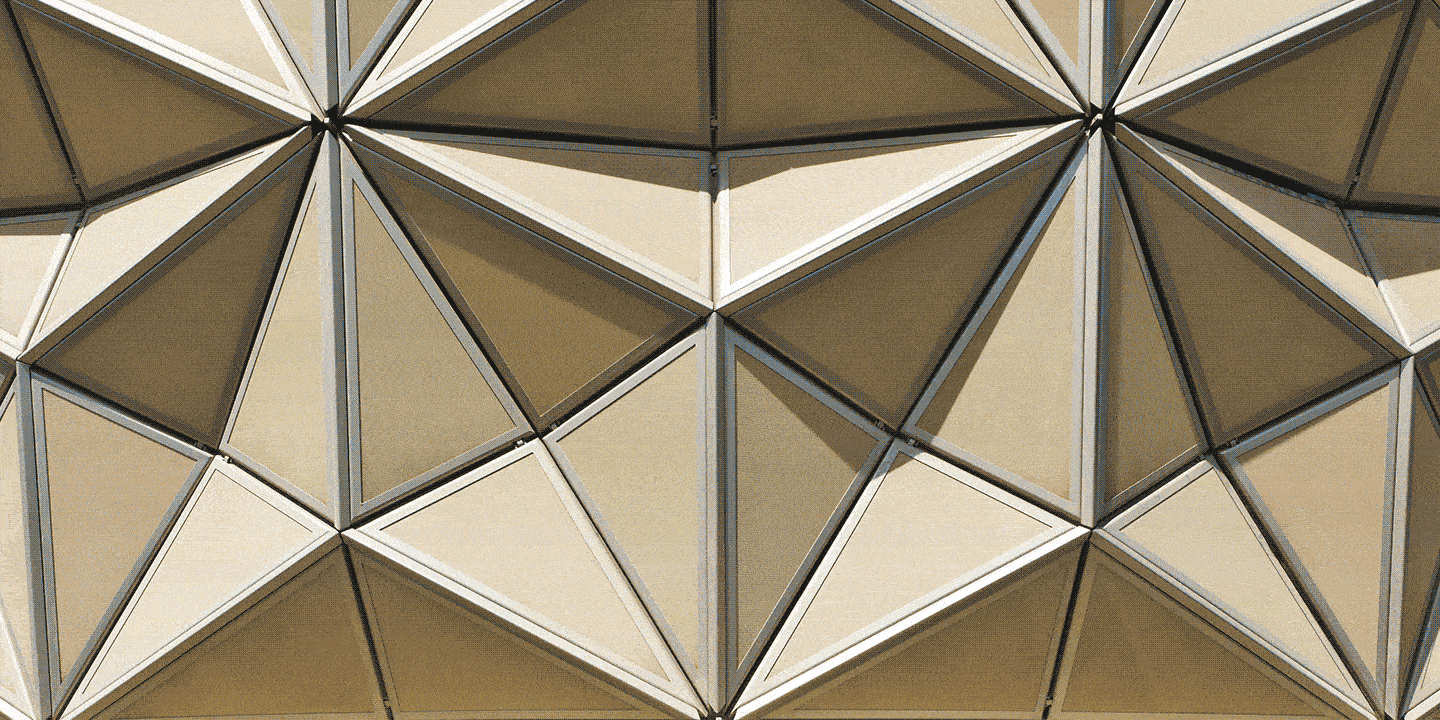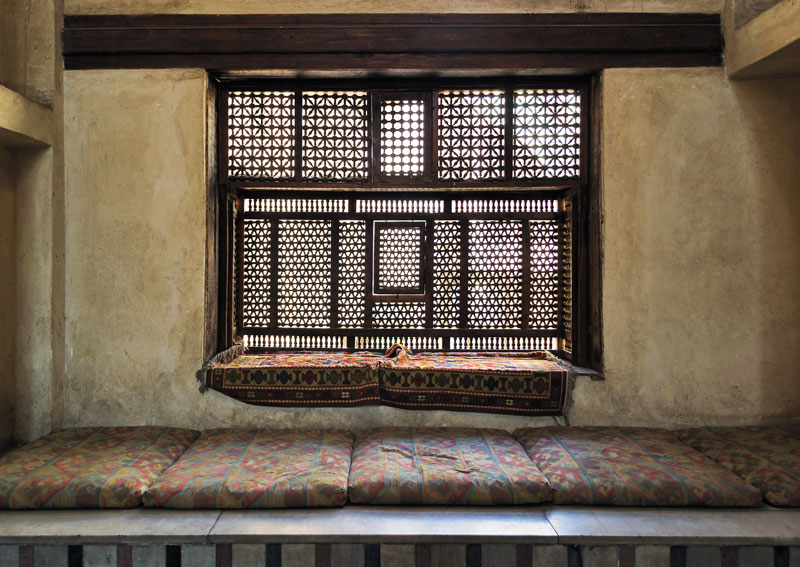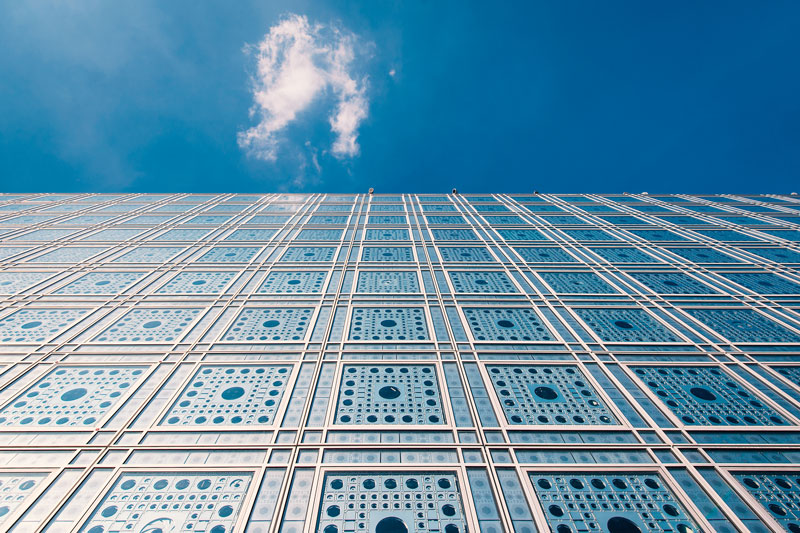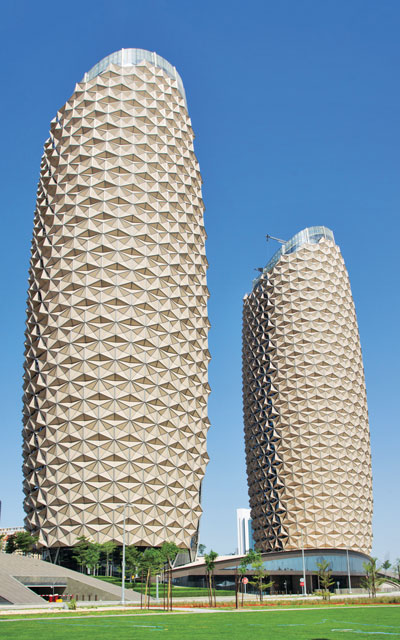
BASED ON ARAB ARCHITECTURAL CONCEPTS
FROM THE MIDDLE AGES, AN ARMY OF SENSORS
ALLOWS THESE TOWERS TO REACT
TO SOLAR RADIATION AND WIND SPEED.
The subtropical desert climate of the United Arab Emirates makes designing architecture that will keep humans comfortable a particularly daunting task. Temperatures in the summer months regularly top 110°F (44°C), and the sun doesn’t quit, even in winter.
Since the Middle Ages, well-heeled Arab homes and palaces have been outfitted with window lattices called mashrabiya, which let in air and some light while blocking much of the day’s heat and protecting the interior from prying eyes. These geometric wooden lattices, sometimes lined with stained glass, are highly decorative as well as functional.
Above GIF: The opening and and closing surfaces—inspired
by mashrabiya window lattices—of the Al Bahr Towers in
Abu Dhabi. Photo courtesy of Christian Richter/Getty.
The Al Bahr Towers in Abu Dhabi have achieved high levels of energy efficiency with a high-tech take on the mashrabiya. An intricate network of folding screens suspended from the twin buildings’ surfaces opens and closes based on the sun’s position, minimizing energy use and maximizing occupant comfort. The buildings are smart, but the solution is surprisingly simple.

Egypt. Image courtesy of Keladawy.
Architectural firm AHR designed the towers for the Abu Dhabi Investment Council and worked together with the global engineering firm Arup, which developed all of the engineering aspects of the design, including the revolutionary facades. The award-winning construction sits on the north shore of Abu Dhabi Island, overlooking the Eastern Mangroves development. The buildings’ design merges environmental efficiency with cultural responsibility.
“It is an adaptive building—the shape and performance react according to the environment,” says Giorgio Buffoni, an associate in the London facade engineering team at Arup. He was involved from the beginning of the facade design in 2007 through the building’s opening in 2012.
This makes the Al Bahr Towers a high-profile and beautiful example of how buildings are taking advantage of the latest wave of sensors. The facade is operated by sun-tracking software that controls the opening and closing sequence according to the sun’s position. Sensors also capture wind speed and solar radiation data to adjust the facade in cases of extreme winds or prolonged overcast conditions.
The towers are not alone in sensing and adapting to their environment. “Smart buildings” and components have been in use for more than a decade, from the ubiquitous motion sensors that turn lighting on or off to Nest thermostats that learn residents’ heating needs to “people counters” that track how many people are using a space and when they use it.
And there are precedents for its big and ambitious adaptive skin. One of the most famous is the Institut du Monde Arabe (Arab World Institute), designed by Jean Nouvel and Architecture-Studio. Built in Paris in the 1980s, it has a facade equipped with photosensitive apertures that also reference the intricate patterns of the Arab world.

Clusters of triangular screens on the Al Bahr Towers form the shape of large flowers blossoming across the two 26-story buildings. Precisely 2098 facade units, each weighing 1.5 tons, are cantilevered 2.8 metres off the building’s surface (to allow access for window cleaning and shading system maintenance).
The shades are made of polytetrafluoroethylene (PTFE), essentially a Teflon-coated fiberglass fabric. The screens vary slightly in size because the towers are not perfectly cylindrical—the shapes of the towers are based on six tangential arcs taken from three intersecting circles, a traditional geometric pattern in the region.
As the sun rises in the east and sets in the west, a control system follows its path, gradually opening and closing the facade panels in response to its position and strength. An anemometer measuring wind speed and a solar radiation sensor on the tops of the buildings can override the preset if there are extreme conditions.
But the facades were designed to operate in an aggressive environment: in addition to high temperatures and occasional high winds, the air is laden with sand, dust, and salt. During the design phase of the project, Arup developed the specifications to be followed for off-site testing, where a full-scale shading unit was subject to 30,000 opening and closing cycles, equivalent to approximately 40 years of use.

2000 umbrella-like glass elements that automatically open
and close depending on the intensity of sunlight. Image
courtesy of Paule Seux/Getty.
“When we prepared our package, there was a worry the project might be perceived as too risky by facade contractors,” Buffoni says. But the winning contractor, Chinese firm Yuanda, was keenly interested in developing the groundbreaking system with Arup and AHR.
The towers themselves resemble palm tree trunks from afar—all sides of the towers are covered with external shading, with the exception of the north, which doesn’t receive direct sunlight, and the very top of the tower, which has glazing with additional ceramic fritting. (One of the towers hosts three skygardens, which are also protected by the external shading.)
Improving the internal comfort for the occupants—with a consequent reduction in energy use—was perhaps the biggest single challenge facing the design team. Buildings in the region are climate-controlled, and because of the year-round high solar radiation levels, most skyscrapers’ glazing is heavily tinted or highly reflective, allowing little natural light into living and work spaces.
“If the glass is dark, you have to have your lights on all day, defeating the concept of a highly glazed building,” Buffoni says. “So a key driver in the design was a more natural view from the building and minimizing the use of artificial light.”
The facades in the Al Bahr Towers were designed to reduce interior heat gain by 50 percent as compared with buildings of similar size in the Middle East, and preliminary studies showed cost savings could be made on energy and subsequent reduction in cooling plant size.
The promise of smart buildings has yet to be realized, but perhaps this simpler take is the way to go. The more complex a system is, the more likely it is to break down. And if a building changes hands, system manuals can be lost, knowledge and training forgotten.
“We know the system is robust and can deliver what we expect,” says Tim Casey, project manager at Arup. “It might not be the most clever, but it is robust. The sensor strategy was to minimize the level of complexity.” And that embodies many of industrial designer Dieter Rams’ 10 principles for good design: it is innovative, useful, long-lasting, and environmentally friendly; good design is as little design as possible. 
This article originally appeared on Autodesk’s Redshift, a site dedicated to inspiring designers, engineers, builders, and makers. Read the original article here.

